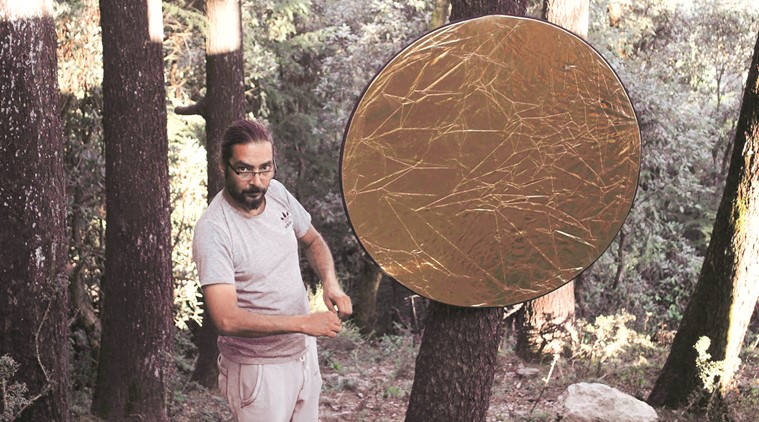Stopping by Woods on a November Evening
A forest land hosts an experimental art project, ‘In the Woods-2’

Installations that are a part of the exhibition.
Sometimes, to think outside the box, one needs to build a box. That is the philosophy of the second edition of the open art exhibition, “In The Woods”, which has been curated and conceptualised in a designated forest land midway between Bir and Billing, above the village of Gunehar, Kangra Valley, in Himachal Pradesh.
Organised and facilitated by The 4tables Project and Frank Schlichtmann, “In the Woods” is an experiment in contemporary art and art practice, with the aim of demonstrating artistic processes to people, especially those not exposed to arts in their everyday lives, and documenting the effects of such exposure.
“In The Woods”, which highlights emerging Indian artists, was conceptualised as a traditional exhibition of artists’ works in an unusual location. But during the last six months, the nature of the second edition kept evolving, adjusting to diminishing resources and time. This year, it’s a virtual representation of arts in the woods. The idea of going totally digital is that, since modern life is dominated by the digital medium, an exhibition, which could come together because of digital technology and the internet, is a reflection of the world we live in.
For the final showcase, poets, video artists and musicians from across India were invited to send their works, for a token fee, in digital form, to be presented during the exhibition, which began in the first week of November. But these works, videos, illustrations, soundscapes, photographs and installations by artists such as Vishal Kumaraswami, Samresh Shrivastava, Onen Atsongchange and Nikhil Natrendra are not being showcased in the open space, but in the closed and restricted space created within black-boxes. This symbolically points out the restrictions the organisers are working under for this edition.
The online platform changed the concept of the exhibition to “Poet-tree and Blackboxes”, the effort being to do justice to the original theme of the exhibition, “crossroads”. For the exhibition, two contrasting layers have been created — the outer, natural, holistic layer being the forest itself, with its whispering poetry trees. Seven young poets — Shantanu Anand, Aishwarya Shrivastav, Don Mihsill, Priyanka Menon, Zainab Kakal, Yamini Krishnan and Rohini Kejriwal — were selected and asked to tape and send digital files of their narrations. The sound of poetry fills the forest, as people walk through it among the poetry whisperings. The ambience is that of a large park, set up in the forest, with sitting arrangements under “the poet-trees”, soft, golden light, and a space to relax.
The inner layer, that is the black boxes, are restricted spaces — dark cubicles that have cut off the forest layer completely and put the visitors in an urban, destructive atmosphere. Blackbox #1 has three video artists — Kumaraswamy, Atsongchange and Shrivastava — depicting images of life in an ever-changing, urban space, on loop on two screens simultaneously. A white jhula, hung from the ceiling, is like a jhula in a small park somewhere in a busy city intersection.
Blackbox #2 has an effectively composed three-track, loud city-noise soundscape (Natrendra). The bare, dark room has nothing as reprieve but a black suitcase, a mute mobile phone and some glitter on the floor. Blackbox #3, on the other hand, is open and has 16 mirrors hanging in it with 15 faces of Gunehar villagers, into which the visitor can project his/her face. The installation is called, People See Themselves In You. You See Yourself In Them, and has been created by Schlichtmann.
The exhibition attempts to take the visitor through these contrasting layers, the crossroad between a rural, natural, harmonious outer layer of poetry and music and an inner layer of destructive, gritty urban sensitivities, like a choice that one has to make about the future of living on this planet. The reactions of the visitors have been varied, as they react to the contrast in strong emotional terms. “One person said, ‘It is so depressing what we are doing to the planet,’ after leaving the black boxes, while many others said that they had to run out from the black boxes to seek reprieve in the poetry forest to calm their nerves,” adds Schlichtmann.
The project has the support of the Himachal Pradesh Government, Department of Language, Art and Culture. Under the umbrella of the department, the idea of a district-wide art and culture event has been planned and is now being implemented. Called the Trigarth Festival, it is a pilot project which will run throughout November in venues across the district. The larger idea is to present programmes in a coordinated manner. “This is a great model of art and culture development. Contemporary art and culture must be supported, so that these can flourish, for a modern India needs a modern art scene.” says Schlichtmann. The next project of the 4tables Project, ShopArt ArtShop-3, will be in summer 2019.






















 Installations that are a part of the exhibition
Installations that are a part of the exhibition
No hay comentarios:
Publicar un comentario